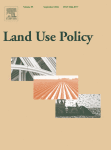Ver ítem
- xmlui.general.dspace_homeCentros Regionales y EEAsCentro Regional Salta - JujuyEEA SaltaArtículos científicosxmlui.ArtifactBrowser.ItemViewer.trail
- Inicio
- Centros Regionales y EEAs
- Centro Regional Salta - Jujuy
- EEA Salta
- Artículos científicos
- Ver ítem
Agricultural expansion in the Semiarid Chaco: poorly selectivecontagious advance
Resumen
Clearance for agriculture or cattle ranching was the dominant land-cover change during the last two decades in the South American Dry Chaco. The Argentinean portion has been particularly affected, presenting greater deforestation rates than the continental and global averages. Little is known on the control factors of the location and the spatial clearance patterns. In this article we studied (a) deforestation dynamics in the Argentinean Dry Chaco and the
[ver mas...]
Clearance for agriculture or cattle ranching was the dominant land-cover change during the last two decades in the South American Dry Chaco. The Argentinean portion has been particularly affected, presenting greater deforestation rates than the continental and global averages. Little is known on the control factors of the location and the spatial clearance patterns. In this article we studied (a) deforestation dynamics in the Argentinean Dry Chaco and the factors determining land clearing locations for the last 25 years; (b) changes in the relative impact of those factors through time and space; and (c) the effect of regulations aimed to control the location and magnitude of land transformation. We also tested the “expansion of the agricultural frontier” hypothesis for the Argentinean Chaco. To identify the factors that defined agricultural expansion we used binomial logistic models that were fitted to a set of independent variables (bio-physical, infrastructure and political factors) that could eventually influence the distribution of new agricultural areas. Results indicate that the Forest Law devised by the Argentinean federal government to control the clearing process was insufficient to restrict both the area transformed per year and clearance locations. Agriculture is expanding over marginal areas and land clearing dynamics have been increasingly associated to the proximity to already cleared areas, defining a frontier—advancement pattern which gives the idea of a contagion process. According to our results, the relative importance of the anthropic factors associated to the agricultural expansion in the region increased through time.
[Cerrar]

Autor
Volante, Jose Norberto;
Mosciaro, Maria Jesus;
Gavier Pizarro, Gregorio Ignacio;
Paruelo, José María;
Fuente
Land use policy 55 : 154-165. (September 2016)
Fecha
2016-09
Editorial
Elsevier
ISSN
0264-8377
Formato
pdf
Tipo de documento
artículo
Palabras Claves
Derechos de acceso
Restringido
 Excepto donde se diga explicitamente, este item se publica bajo la siguiente descripción: Creative Commons Attribution-NonCommercial-ShareAlike 2.5 Unported (CC BY-NC-SA 2.5)
Excepto donde se diga explicitamente, este item se publica bajo la siguiente descripción: Creative Commons Attribution-NonCommercial-ShareAlike 2.5 Unported (CC BY-NC-SA 2.5)

